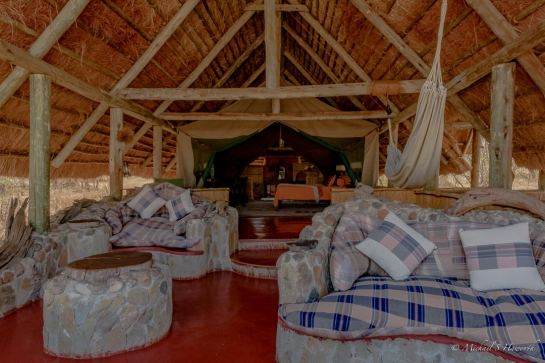This is the last post from my trip to Ruaha National Park with Andrew Beck of Wild Eye in November 2018. We were based at the Mwagusi safari camp. This was a special wild place which infused you with a deep sense of wild Africa.
“The cool morn disguised the midday heat. The lively chorus at dawn celebrated the night’s survival. The darkness faded and so too did the haunting calls in the night. The African bush filled your senses and your imagination.” ~Mike Haworth
This first image is a view from my banda at 5h30 in the morning around 10 minutes before sunrise. Coffee had just been delivered and I could sit quietly and watch a new Africa day light up across the dry Mwagusi river bed. The sounds were indescribable with birds singing, spurfowl calling and the hyaenas whooping as they made their way back to their dens. In the distance lion were often heard roaring in the cool air as their roars carried further in the dense cool air.

” There are a few in this world who have the good sense to carve out small sanctuaries in the African bush for ordinary people to visit and be privileged to have the African bush reveal itself with all its wonder.” ~ Mike Haworth
A view of the inside of the banda I stayed in while in the Mwagusi safari Camp. It was spacious and very comfortable. It had a large veranda with big cushions covering a concrete seat and in case that was too hard there was a hammock swinging slightly in the light breeze.

A view from the bathroom through the bedroom out onto the river. As you can see the partitions were made of reeds. The floors were polished red concrete. The main bedroom was a tent which could be closed up at night. Each banda had en-suite facilities with flushing toilet and an ample supply of hot water for the shower and sink.

A view from the veranda of my banda at midday looking across the dry Mwagusi river to the main dining area.

Each banda had a large covered veranda, with a cushioned seating area and inviting hammock designed to catch any breeze in the midday heat. This was a perfect place to sit first thing in the morning watching the sun rise and to relax in the afternoon heat.

A view of the approach to my banda showing the peaked roof of Makuti thatch constructed from palm leaves.

“It is only by going to new places can your experience of life be deepened. Only then to you understand the value in the diversity and being able to sense the similarities and connections of life.”~ Mike Haworth
A view down onto the dry Mwagusi river bed from just in front of the dining area.

On our third morning we were barely five minites out of camp having just crossed the dry Mwagusi river when we found a pack of wild dogs. There was a concentration of predators around the Mwagusi safari camp when we were there.

Looking from the main dining area to the left set of bandas positioned along the bank of the Mwagusi river.

There was much bird activity around the bird baths in the heat of the early afternoon. A whole family of red-necked spurfowl gathered for a drink.

A view from the river bank towards the main dining area. The standard of food was exceptional. The manner in which it was served was first class. Each evening we were treated to a dinner in the river bed in a different location with lanterns lighting the sandy river bed creating just the sort of romanticism which makes you fall in love with the wild African bush.

” In an African sunset you will be immersed in colour and beauty which seems dreamlike. Your senses will be flooded with the heat, fragrances, colours and sounds of that inbetween time.”~ Mike Haworth
A view of the dry Mwagusi river just next to the camp at last light.

Our ‘wheels’ for the trip with Yona as driver and Justin as our guide. Both were very hospitable and Justin had exceptional knowledge of the wildlife, trees and birds. Both were a pleasure to travel with around Ruaha.

Ruaha has its own unique way of displaying its road signs. Each road has a different animal sign mounted on top of a colourful base.

There were a number of bird baths in front of the main dining area and another next to the reading room. We spent time editing our images in the reading room but there were many distractions such as this palm-collared thrush which was frequent visitor to the bird bath in the middle of the day.
“I hope you have an experience that alters the course of your life because, after Africa, nothing has ever been the same” ~ Suzanne Evans

A view along the Mwagusi river immediately behind the camp at last light.

Wild Ruaha was an intense experience. It overloaded your senses. Everything was brand new. November was hot. The bush offered new sights, smells and fragrances, and it was teeming with wildlife and yes, the insects bite.
“You were born to dance to the beat of your own heart,
To roam without cages, with the innocence of a child and the free spirit of untamed horses.
I hope you laugh without stopping, live with abandon, and love like all there is. Stay wild, my wild, wild child.” ~ unknown
Explore, seek to understand, marvel at its inter-connectedness and let it be.
Have fun, Mike













































